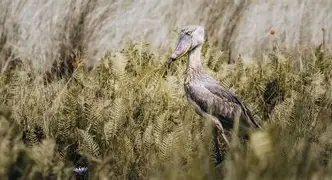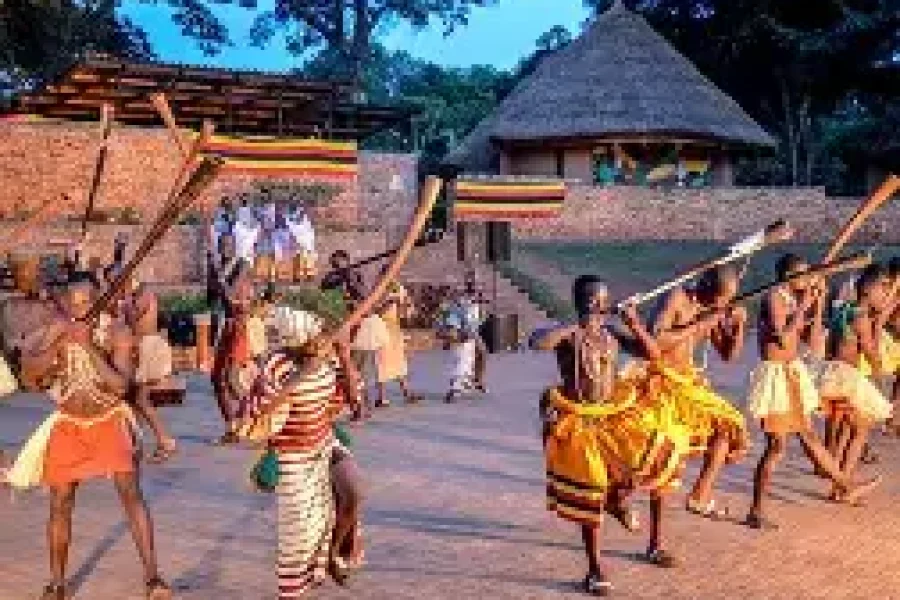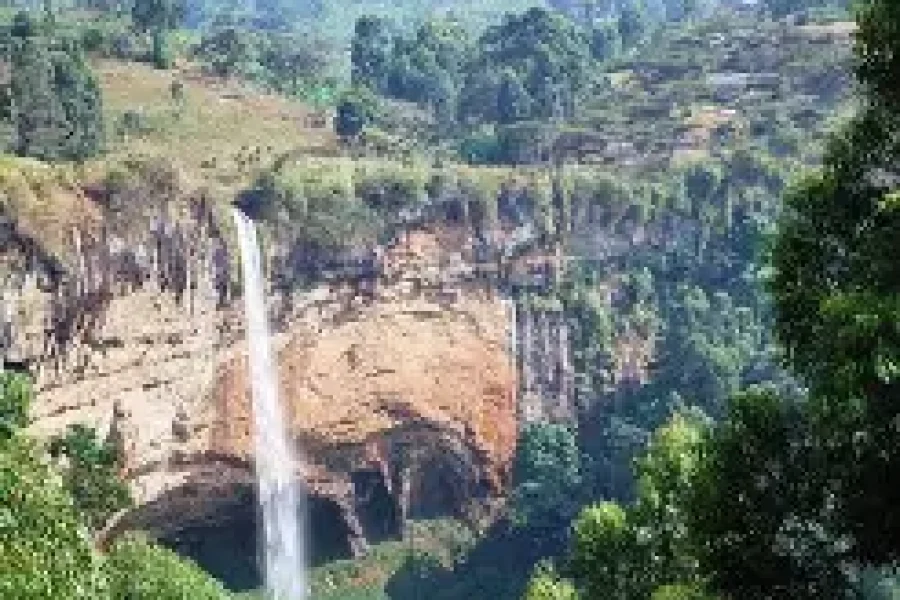Best African Safaris & Travel Services – African Authentic Safaris Ltd
Half-Day Shoebill Watching Tour in Mabamba Wetland
from 0 review
Day Trip
Daily Tour
Unlimited
___
Description
Experience one of Africa’s most sought-after birding adventures with our ½-Day Shoebill Watching Tour in Mabamba Wetland. Just 40 kilometers west of Entebbe, this remarkable papyrus swamp offers the world’s most reliable viewing opportunities for the prehistoric-looking shoebill stork – a bird that tops every wildlife enthusiast’s must-see list. This specialized tour takes you deep into the maze-like channels of Mabamba in traditional wooden canoes, where expert local guides navigate through floating vegetation in search of this elusive avian giant. Standing up to 5 feet tall with its distinctive shoe-shaped bill, the shoebill represents one of birding’s most thrilling sightings. Beyond this flagship species, the wetland hosts over 260 bird species in a pristine ecosystem designated as an Important Bird Area and Ramsar site. Perfect for serious birders, wildlife photographers, and nature enthusiasts, this convenient half-day format delivers an extraordinary wildlife experience within easy reach of Entebbe, combining remarkable biodiversity with the adventure of traditional canoe exploration.
Highlights
- · Search for the elusive shoebill stork with a high success rate of 70-80%
- · Expert guidance from specialized local bird guides who know the shoebill territories
- · Traditional wooden canoe exploration through scenic papyrus channels
- · Opportunity for exceptional wildlife photography in natural wetland settings
- · Over 260 bird species potential sightings beyond the shoebill
- · Support local community conservation through a sustainable eco-tourism model
- · Convenient half-day format perfect for layovers or limited schedules
- · Pristine wetland ecosystem recognized as an Important Bird Area
- · Spectacular Lake Victoria views during the journey
- · Minimal physical exertion required as guides paddle the canoes
Detailed Itinerary

Morning Tour Option (06:30 AM - 12:30 PM) 06:30 AM: Departure from Entebbe · Early morning pick-up from your Entebbe hotel or residence · Meet your professional bird guide and receive a briefing on the day’s activities · Begin the scenic drive to Mabamba Wetland · Bird watching begins immediately along the route 07:30 AM: Arrival at Mabamba Wetland · Reach the Mabamba landing site on Lake Victoria · Welcome by local community guides · Introduction to the wetland ecosystem and shoebill biology · Brief orientation on canoe safety and wetland etiquette · Opportunity for restroom break before boarding canoes 07:45 AM - 10:45 AM: Canoe Safari in Mabamba Wetland · Board traditional wooden canoes with experienced local paddlers · Navigate through narrow channels and openings in the papyrus · Active search for shoebills in their preferred hunting grounds · Expert guides communicate with other canoes to maximize sighting opportunities · Observe numerous other bird species along the way · Photography opportunities in optimal morning light · Refreshment break during the excursion · Extended observation time if shoebills are located 10:45 AM: Return to Landing Site · Conclude the wetland exploration · Debriefing with guides about the morning’s sightings · Refreshment break with light snacks · Visit to the community conservation center (if time permits) 11:15 AM: Departure from Mabamba · Begin return journey to Entebbe · Bird watching continues along the route · Reflection on the experience and wildlife sightings 12:30 PM: Arrival in Entebbe · Drop-off at your Entebbe hotel or residence · End of tour services Afternoon Tour Option (12:00 PM - 06:00 PM) 12:00 PM: Departure from Entebbe · Pick-up from your Entebbe hotel or residence · Meet your professional bird guide and receive a briefing on the day’s activities · Begin the scenic drive to Mabamba Wetland · Bird watching begins immediately along the route 01:00 PM: Arrival at Mabamba Wetland · Reach the Mabamba landing site on Lake Victoria · Welcome by local community guides · Introduction to the wetland ecosystem and shoebill biology · Brief orientation on canoe safety and wetland etiquette · Opportunity for restroom break before boarding canoes 01:15 PM - 04:15 PM: Canoe Safari in Mabamba Wetland · Board traditional wooden canoes with experienced local paddlers · Navigate through narrow channels and openings in the papyrus · Active search for shoebills in their preferred hunting grounds · Expert guides communicate with other canoes to maximize sighting opportunities · Observe numerous other bird species along the way · Photography opportunities with afternoon lighting · Refreshment break during the excursion · Extended observation time if shoebills are located 04:15 PM: Return to Landing Site · Conclude the wetland exploration · Debriefing with guides about the afternoon’s sightings · Refreshment break with light snacks · Visit to the community conservation center (if time permits) 04:45 PM: Departure from Mabamba · Begin return journey to Entebbe · Bird watching continues along the route · Reflection on the experience and wildlife sightings 06:00 PM: Arrival in Entebbe · Drop-off at your Entebbe hotel or residence · End of tour services
- · Professional English-speaking bird guide with shoebill expertise
- · Local community canoe guide and paddler at Mabamba Wetland
- · Comfortable transportation to and from Entebbe
- · Traditional wooden canoe and safety equipment
- · Wetland entrance and conservation fees
- · Bottled water and light refreshments
- · Binoculars (one pair per vehicle)
- · Bird checklist of Mabamba species
- · All government taxes applicable to the activity
- · Pick-up and drop-off in Entebbe
- · Contribution to local community conservation through tour fees
- · Meals beyond light refreshments
- · Personal travel insurance (recommended)
- · Specialized photography equipment rental
- · Waterproof gear (available for rent at additional cost)
- · Tips and gratuities for guides (recommended: $5-10 per guide)
- · Personal expenses and items of a personal nature
- · Optional activities beyond those listed in the itinerary
- · International or domestic flights
- · Accommodation in Entebbe
Tour's Location
1. What are the chances of actually seeing a shoebill during this half-day tour?
The success rate for shoebill sightings at Mabamba Wetland is approximately 70-80%, which is among the highest for shoebill viewing anywhere in Africa. Our combination of expert guides, coordinated search strategies, and intimate knowledge of shoebill territories significantly increases your chances of a successful sighting. Morning tours generally have a slightly higher success rate (75-85%) compared to afternoon excursions (65-75%) as shoebills are often more active hunters in the morning hours. While sightings can never be guaranteed with any wild animal, Mabamba Wetland is widely recognized as the most reliable location for shoebill viewing in the world. On the rare occasions when shoebills aren’t found, the wetland’s extraordinary diversity of other bird species still makes for an exceptional wildlife experience.
2. What exactly is a shoebill, and why is it so special to see one?
The shoebill (Balaeniceps rex) is one of the world’s most distinctive and ancient-looking birds, often described as “prehistoric” or “dinosaur-like” in appearance. Standing up to 1.5 meters (5 feet) tall with a wingspan of up to 2.6 meters (8.5 feet), its most striking feature is the massive shoe-shaped bill that gives the species its name. This specialized bill is perfectly adapted for catching lungfish and other prey in shallow wetlands. Shoebills are classified as vulnerable on the IUCN Red List with a declining global population estimated at only 5,000-8,000 individuals, making each sighting precious. Their limited range (primarily wetlands in East and Central Africa), solitary nature, and habitat in remote swamps make them exceptionally difficult to observe in the wild. For serious birders, wildlife photographers, and nature enthusiasts, spotting a shoebill represents one of Africa’s most coveted wildlife experiences and often features on “bucket list” sightings.
3. What other birds and wildlife might we see besides the shoebill?
Mabamba Wetland hosts over 260 bird species, making every excursion a rich birding experience regardless of shoebill sightings. Common species you’re likely to encounter include: Waterbirds: · African jacana (lily trotter) · Purple swamphen · Various heron species (goliath, purple, black-headed) · African fish eagle · Malachite and pied kingfishers · African pygmy goose · Long-tailed cormorant · Papyrus gonolek · Blue-headed coucal Migratory species (seasonal): · Blue swallow · White-winged tern · Gull-billed tern · Whiskered tern Other wildlife occasionally seen includes: · Monitor lizards · Sitatunga (aquatic antelope) · Various butterfly species · Mongooses along the shoreline · Numerous amphibian species Our guides are expert at identifying even the most challenging species, making this an excellent opportunity for both beginner and experienced birders to expand their life lists
4. What is the best time of day to see shoebills at Mabamba Wetland?
Early morning (6:30 AM - 10:30 AM) generally offers the optimal conditions for shoebill watching at Mabamba for several reasons: · Shoebills are most active hunters during the cooler morning hours · Wind conditions are typically calmer, making canoe navigation easier · Morning light provides better visibility into the papyrus thickets · Fewer other visitors create a more serene experience · Photography conditions are superior with soft morning light That said, our afternoon tours (starting at 12:00 PM) still maintain a good success rate and offer advantages for those unable to join morning excursions. Shoebills often remain stationary for extended periods while hunting, making them potentially visible throughout the day. The afternoon light can create dramatic photography opportunities with golden backlighting. For photographers seeking specific lighting conditions or visitors with time constraints, we’re happy to advise on the best timing for your specific circumstances and preferences.
5. How physically demanding is the canoe safari portion of this tour?
The canoe safari portion is minimally physically demanding, making it accessible to most visitors regardless of age or fitness level. Key aspects include: · Local guides do all the paddling – you simply sit and observe · Traditional wooden canoes are stable and comfortable (though basic) · No hiking or walking is required beyond boarding the canoe · The excursion involves sitting for 2-3 hours with occasional stretching opportunities · Canoes include basic back support, though not luxurious seating · The wetland waters are calm with no rapids or significant waves · Guides can adjust the duration based on comfort levels The primary physical requirements are the ability to step into and out of a canoe (with assistance provided) and comfort sitting for extended periods. We recommend bringing a small cushion if you have back concerns. This accessibility makes the tour suitable for birders of all ages, including seniors and those with minor mobility limitations. For visitors with specific physical concerns, please contact us in advance so we can make appropriate arrangements.
6. What should I bring and wear for optimal shoebill watching?
For the most comfortable and productive shoebill watching experience, we recommend: Essential items: · Binoculars (though we provide a pair per vehicle) · Camera with zoom lens (200mm+ recommended for good shoebill photos) · Hat with brim for sun protection · Sunscreen and insect repellent · Small daypack for personal items · Waterproof bag or cover for electronic equipment · Drinking water (though we provide bottled water) Recommended clothing: · Lightweight, neutral-colored clothing (avoid bright colors) · Long-sleeved shirts and long pants for sun/insect protection · Light rain jacket or poncho (weather can change quickly) · Waterproof footwear or shoes you don’t mind getting slightly damp Optional but useful: · Birding field guide to East Africa · Personal bird checklist if you’re keeping records · Small cushion for additional comfort in the canoe · Polarized sunglasses to reduce water glare · Waterproof or water-resistant pants for the very cautious Morning departures can be cool, so a light jacket is recommended, while afternoon tours require more sun protection.
7. What is the best season for shoebill watching at Mabamba?
Shoebill watching at Mabamba is a year-round activity with good success rates in all seasons, though there are seasonal variations worth considering: Dry Seasons (December-February and June-September): · Generally easier navigation through the wetland · More concentrated bird activity around remaining water channels · Slightly higher shoebill sighting rates (80-85%) · More comfortable conditions with less chance of rain · Potentially more mosquitoes as they concentrate near water Wet Seasons (March-May and October-November): · Lush, vibrant wetland vegetation · Higher water levels creating more extensive habitat · Slightly more challenging to locate shoebills (65-75% success) · Possibility of brief rain showers · Fewer visitors creating more exclusive experiences · Additional migratory bird species present For dedicated birders seeking the absolute optimal conditions, the early dry season (December-January and June-July) typically offers the best combination of shoebill activity, comfortable conditions, and overall bird diversity. However, the tour operates successfully year-round, and shoebills are resident, non-migratory birds.
8. How does this tour support local conservation efforts?
This tour directly contributes to conservation through several important mechanisms: Community-based conservation: · Local community members receive direct employment as guides and canoe paddlers · A portion of tour fees goes to the Mabamba Wetland Eco-tourism Association · Alternative livelihoods reduce pressure on wetland resources from fishing and harvesting · Local guides are trained in sustainable tourism practices and bird monitoring Habitat protection: · Tourism value creates economic incentive to maintain wetland integrity · Regular presence of guides and tourists deters illegal activities in the wetland · Data collected on shoebill sightings contributes to scientific monitoring · Increased awareness of Mabamba’s importance strengthens protection efforts Conservation awareness: · Educational component of the tour promotes understanding of wetland ecology · Visitors become ambassadors for shoebill and wetland conservation · Documentation of wildlife sightings supports conservation research · International attention helps maintain Mabamba’s protected status By choosing this tour, you’re directly supporting a model where local communities benefit economically from preserving rather than exploiting natural resources, creating sustainable protection for one of East Africa’s most important wetland ecosystems.
9. Is this tour suitable for children or non-birders
This tour can be enjoyable for children and non-birders under certain conditions: For children: · Generally suitable for children aged 6 and above who can sit quietly · The canoe journey itself is often fascinating for children · Morning tours are recommended as they’re shorter and more active · The “prehistoric” appearance of shoebills captivates many children · Guides can adapt their commentary to engage younger visitors · Parents should be realistic about their child’s ability to remain relatively quiet and still For non-birders: · The unique ecosystem exploration is interesting regardless of birding interest · The adventure aspect of canoe travel appeals to many non-specialists · Shoebills are so distinctive that even non-birders find them fascinating · Guides can focus more on general ecosystem information rather than detailed bird identification · The photographic opportunities appeal to many non-birders · The cultural aspect of traditional canoe travel adds interest For mixed groups with varying interests, we recommend the slightly shorter morning tour and communicating with your guide about the group’s specific interests. Non-birders frequently report being unexpectedly captivated by the experience, particularly when a shoebill is successfully located.
10. How does the Mabamba Wetland shoebill experience compare to other shoebill viewing locations in Uganda?
Mabamba Wetland offers several distinct advantages for shoebill watching compared to other locations in Uganda: Compared to Murchison Falls National Park: · Higher success rate for shoebill sightings (70-80% vs. 40-50%) · Much closer to Entebbe/Kampala (40 km vs. 300+ km) · More intimate viewing experience from canoes vs. larger boats · Focus specifically on shoebills rather than general wildlife viewing · Traditional canoe experience vs. motorized boats · Lower cost and time commitment (half-day vs. multi-day) Compared to Makanaga Wetland: · More extensive wetland system with multiple shoebill territories · Better established tourism infrastructure · Higher success rates due to coordinated guide network · Community-based conservation model in place · More accessible in various weather conditions Compared to Ziwa Rhino Sanctuary wetlands: · Primary focus on shoebills rather than rhinos · Traditional canoe experience instead of walking · More extensive wetland habitat specifically managed for birds · Higher concentration of other wetland bird species · Specialized guides focused exclusively on bird finding While each location has its merits, Mabamba is widely recognized by birding experts as Uganda’s premier shoebill watching destination, offering the optimal combination of high success rate, accessibility from Entebbe, and specialized guiding. For visitors with limited time who prioritize seeing this remarkable species, Mabamba represents the definitive choice.





Leave a review